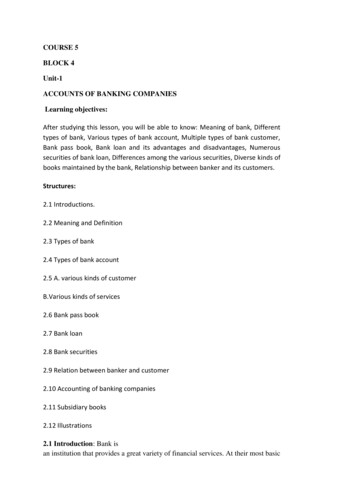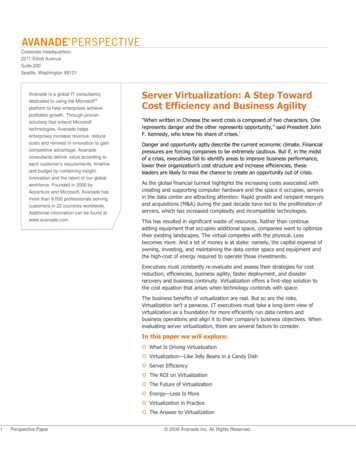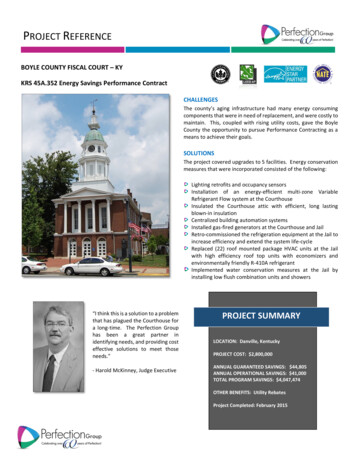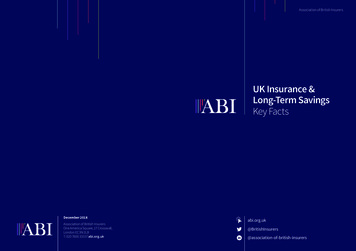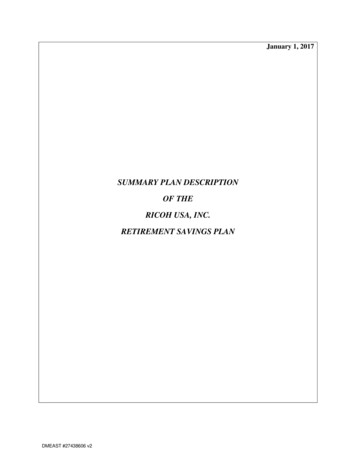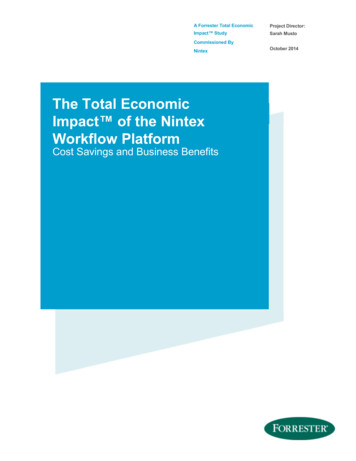
Transcription
A Forrester Total EconomicProject Director:Impact StudySarah MustoCommissioned ByNintexThe Total EconomicImpact of the NintexWorkflow PlatformCost Savings and Business BenefitsOctober 2014
Table Of ContentsExecutive Summary . 3Disclosures . 4TEI Framework and Methodology . 5Analysis . 6Financial Summary . 21Nintex Workflow Platform: Overview. 22Appendix A: Composite Organization Description . 23Appendix B: Total Economic Impact Overview . 24Appendix C: Glossary . 25Appendix D: Supplemental Material . 26Appendix E: Endnotes . 26ABOUT FORRESTER CONSULTINGForrester Consulting provides independent and objective research-basedconsulting to help leaders succeed in their organizations. Ranging in scope from ashort strategy session to custom projects, Forrester’s Consulting services connectyou directly with research analysts who apply expert insight to your specificbusiness challenges. For more information, visit forrester.com/consulting. 2014, Forrester Research, Inc. All rights reserved. Unauthorized reproduction is strictly prohibited.Information is based on best available resources. Opinions reflect judgment at the time and are subject tochange. Forrester , Technographics , Forrester Wave, RoleView, TechRadar, and Total Economic Impactare trademarks of Forrester Research, Inc. All other trademarks are the property of their respectivecompanies. For additional information, go to www.forrester.com.
3Executive SummaryNintex commissioned Forrester Research to conduct a TotalEconomic Impact (TEI) study and examine the potentialreturn on investment (ROI) that enterprises may realize bydeploying Nintex’s workflow platform. The purpose of thisstudy is to provide readers with a framework to evaluate thepotential financial impact of using the Nintex workflow platformwithin their organizations.“With Nintex, we now have the time to not onlydeliver workflows, but also to spend timeanalyzing the process and to make sure that weare delivering something in a smarter way.”— Workflow architectTo better understand the benefits, costs, and risks associatedwith the implementation of the Nintex workflow platform, which we will refer to as the Platform, Forrester interviewed severalcustomers with multiple years of experience using Nintex Workflow and Nintex Forms. These customers recognize the valueinherent in automating processes. Their colleagues and customers are working both in offices and on mobile devices andare spread across many countries. Content necessary to collaborate and make business decisions is stored in manyapplications across these devices. They have some well-defined processes, but the steps leading up to these processes orto connect closely related processes are loosely defined and manual. With Nintex Workflow, customers can automate theirprocesses and create workflows that connect their people, processes, and content. With Nintex Forms, Nintex provides aneasy way to collect data from colleagues and customers within the workflow. Using Nintex Mobile, customers can extendthese workflows to users who are on the go. With Nintex Connectors, customers can easily integrate cloud services and lineof-business applications into their workflows.Prior to using the Platform, these customers were mostly relying on custom code to automate processes. However, it wasdifficult and time-consuming to build workflows, and many processes remained manual (e.g. paper-based, email, excel files)while a backlog of requests for automation grew. This left customers frustrated with process inefficiencies and the inability toautomate faster. With the Platform, customers are able to automate processes in pace with demand, connect the rightpeople and data in each process, and easily make changes to workflows as processes change. This results in increasedproductivity for end users and IT, reduced costs associated with automation, better collaboration, and higher quality of work.NINTEX ENABLES INCREASED PRODUCTIVITY AND SIMPLER WORKFLOW MANAGEMENTOur interviews with five existing customers and subsequent financial analysis found that a composite organization, which we1will refer to as the Organization, based on these interviewed organizations experienced the risk-adjusted ROI , benefits, andcosts shown in Figure 1. See Appendix A for a description of the Organization.The analysis points to benefits of just over 1.6 million over three years versus costs of 580,000, adding up to a net presentvalue (NPV) of 1,020,045.FIGURE 1Financial Summary Showing Three-Year Risk-Adjusted ResultsROI:176%Source: Forrester Research, Inc.NPV: 1,020,000Payback:10.5 monthsProductivityper user: 8% to 15%
4››Benefits. The Organization experienced the following risk-adjusted benefits that represent those experienced by theinterviewed companies: Improved productivity for business end users results in benefits of 622,000 in Year 3. Business end users22save on average 1 hour for complex processes and 15 minutes for simple processes automated with Nintex. Improved productivity for IT full-time equivalents (FTEs) provides 77,000 to 91,000 in benefits each year.The Organization was able to automate select processes used by the IT organization, which saved frequent users ofthese processes an average of 3 hours per week. Avoided cost from using Nintex versus relying on custom code. The Organization previously used customcode to automate processes. To replicate the automation achieved with the Platform, the Organization would havespent on average 77,000 per year for internal resource time.Costs. The Organization experienced the following risk-adjusted costs: Licensing fees for the Enterprise Edition of the Nintex workflow platform. The Organization paid 64,000upfront for the Enterprise Edition and paid 22,400 every year for software assurance and premium support. Professional services costs for assistance with initial workflows. The Organization engaged with a partner forhelp in the development and deployment of the first six complex workflows. This resulted in a 300,000 cost. Resource costs for an architect and support staff to manage Nintex. One FTE is responsible for developingNintex workflows for the Organization, and a team of three FTEs are responsible for implementation and ongoingsupport. Business end user resource cost for time spent on workflows. Business end users spend 2 hours per simpleworkflow and 20 hours per complex workflow to assist in validation and testing. Three business specialists aretrained to help develop simple workflows for end users. Training costs of 5,000 upfront. This is to provide training on the Platform for the team of three IT FTEs and thethree business specialistsDisclosuresThe reader should be aware of the following:›The study is commissioned by Nintex and delivered by Forrester Consulting. It is not meant to be used as a competitiveanalysis.›Forrester makes no assumptions as to the potential ROI that other organizations will receive. Forrester strongly advisesthat readers use their own estimates within the framework provided in the report to determine the appropriateness of aninvestment in the Nintex workflow platform.›Nintex reviewed and provided feedback to Forrester, but Forrester maintains editorial control over the study and itsfindings and does not accept changes to the study that contradict Forrester's findings or obscure the meaning of the study.›Nintex provided the customer names for the interviews but did not participate in the interviews.›All financial data is in US dollars.
5TEI Framework and MethodologyINTRODUCTIONFrom the information provided in the interviews, Forrester has constructed a Total Economic Impact (TEI) framework forthose organizations considering implementing the Nintex workflow platform. The objective of the framework is to identify thecost, benefit, flexibility, and risk factors that affect the investment decision.APPROACH AND METHODOLOGYForrester took a multistep approach to evaluate the impact that Nintex can have on an organization (see Figure 2).Specifically, we:›Interviewed Nintex marketing, sales, leadership, and partners, along with Forrester analysts, to gather data relative toNintex and the marketplace for workflow automation tools.›Interviewed five organizations currently using the Platform to obtain data with respect to costs, benefits, and risks.›Designed a composite organization based on characteristics of the interviewed organizations (see Appendix A).›Constructed a financial model representative of the interviews using the TEI methodology. The financial model ispopulated with the cost and benefit data obtained from the interviews as applied to the composite organization.›Risk-adjusted the financial model based on issues and concerns the interviewed organizations highlighted in interviews.Risk adjustment is a key part of the TEI methodology. While interviewed organizations provided cost and benefitestimates, some categories included a broad range of responses or had a number of outside forces that might haveaffected the results. For that reason, some cost and benefit totals have been risk-adjusted and are detailed in eachrelevant section.Forrester employed four fundamental elements in modeling the TEI of the Platform: benefits, costs, flexibility, and risks.Given the increasing sophistication that enterprises have regarding ROI analyses related to IT investments, Forrester’s TEImethodology serves to provide a complete picture of the total economic impact of purchase decisions. Please see AppendixB for additional information on the TEI methodology.FIGURE 2TEI ApproachPerformdue diligenceSource: Forrester Research, zationConstructfinancialmodel usingTEI frameworkWritecase study
6AnalysisCOMPOSITE ORGANIZATIONFor this study, Forrester conducted a total of five interviews with representatives from the following companies, which areNintex customers:›A global pharmaceutical company based in the United States with recent fiscal year revenue of over 45 billion and over70,000 employees. The organization has been using the Nintex workflow platform for three years, and it currently hasdeveloped more than 700 workflows.›A global manufacturing organization headquartered in Europe and operating in more than 100 countries. Its recent fiscalyear revenue is over 4 billion, and it currently has over 15,000 employees. The organization has used the Nintex workflowplatform for three years and has developed 70 workflows.›A Southeast Asian branch of a global banking organization with approximately 4,000 employees. The organization hasbeen using the Nintex workflow platform for one year and has developed 25 workflows.›A nonprofit organization operating in 120 offices in the United States with recent fiscal year revenue of 650 million and3,500 employees. The organization has used the Nintex workflow platform for two years and currently has developed 45workflows.›A division of a global building technologies company headquartered in the United States with 120,000 employees. Theorganization has been using the Nintex workflow platform for one year and has developed about 50 workflows.Based on the interviews, Forrester constructed a TEI framework, acomposite organization, and an associated ROI analysis thatillustrates the areas financially affected. The Organization, thecomposite organization that Forrester synthesized from theseresults, represents an organization with the following characteristics(see Appendix A for more detail):›Is a US-based global organization with 700 million in revenue inthe most recent fiscal year.›Has 3,800 employees worldwide.›Has a number of paper-based and manual processes and isstandardized on a collaboration and content managementsystem like SharePoint or Office 365.After an extensive RFP and business case process evaluatingmultiple vendors, the Organization chose Nintex and begandeployment:“By replacing email-basedprocesses with a smallworkflow, I have created ameasurable process. I can nowtell what point we’re at in theworkflow, and take correctiveaction to improve efficiency.” Director of collaboration, knowledge management›The Organization purchased the Enterprise Edition of the Nintexworkflow platform.›Implementation of the Platform took three FTEs one week tocomplete.›In the initial four months, as part of the proof of concept (POC), the Organization contracted with a partner to help build six3of the most commonly used and complex workflows. The Organization also has one architect responsible for developing
7Nintex workflows. This architect worked with the professional services staff as a form of training and also built an additionalfour simple workflows in this four-month period.›The Organization deployed these initial 10 workflows two yearsago, and then relied on internal FTEs for ongoing workflowdevelopment and management of the Platform. By the end ofYear 3, the Organization expects to have developed 60 workflowsin total, 54 of which automate business processes and six ofwhich automate IT processes. Of those 60 total workflows, 30%are automating complex processes and 70% are automatingsimple processes.INTERVIEW HIGHLIGHTSThe Organization’s experience prior to and after implementing thePlatform is consistent with common themes revealed in the fivecustomer interviews.“We have several exampleswhere our workflows need totalk to another system, and thefact that we can do that withNintex is definitely a winningfactor.” Workflow architectSituationBefore the Organization decided to invest in the Platform, it struggled with a number of challenges in process automation.›The Organization relied on custom code to develop workflows to automate processes. Due to the difficulty in developingwith custom code, creating workflows was very time-consuming and inflexible to process changes upon completion. As thepipeline of requests for automation from the business grew, the relationship between IT and business users becameincreasingly strained.›Since previous process automation was so slow, most processes remained manual. Many processes were handledthrough the use of Excel spreadsheets, email, conference calls, and sending paper documents through an approval chain.This resulted in a lack of efficiency, issues with quality and consistency in processes, and lack of transparency into processcompletion.›The Organization made the decision to standardize on a content and collaboration platform like SharePoint across all ofthe business units for collaboration purposes and as a document repository. In looking for a new solution for workflowdevelopment, the Organization knew that it wanted a tool that could interact easily with its content and collaborationsolution.SolutionThe Organization selected the Nintex workflow platform for its intuitive workflow designer, logic and flow, ease of use andimplementation, ability to integrate with other systems within a workflow, and user interaction. Additionally, because theworkflow designer works with SharePoint and/or Office 365, standardizing across the organization on Nintex for workflowdevelopment complements the Organization’s existing technology strategy.ResultsThe Organization found that:›Automating processes with the Nintex workflow platform has enabled productivity gains for the business and IT.The most significant benefit of using the Platform has been improved process efficiencies due to workflows. Shortly afterdeploying the first set of workflows, users of those processes began to realize time savings. Over time, as user adoptiongrew and new workflows were introduced, these time savings compounded. Additionally, processes are conducted more
8consistently, with fewer errors or delays; workflows ensure that every process that’s started is compliant with regulationsand doesn’t result in litigation; and interactions with customers and other external parties can be completed more efficientlyand in line with best practices. Aside from the monetary value of this time saved, nonquantifiable benefits that theOrganization experienced because of these improvements include reduced fines and litigation costs, better engagementand collaboration with colleagues and external partners, higher customer satisfaction, and incremental revenue fromcompleting projects more quickly.›Developing workflows with a drag-and-drop designer speeds delivery of automation and opens the door forpartnership with business users. With the Platform, the Organization is able to reduce the amount of time it takes todevelop workflows by an average of 60%. Previous frustrationsaround the pipeline of requests from the business to automateprocesses are significantly reduced. In addition, the Organization isable to create more flexibility for end users by providing them the“We needed to create a betteroption to build simpler workflows on their own. A three-person ITteam acting as a Nintex Center of Excellence (CoE), including anrelationship between our usersarchitect to build Nintex workflows, has also trained three businessand IT. After deployingend users who are more tech-savvy to act as business specialistsin their regions. Business users who want to automate a simpleNintex, we now work asprocess then have the ability to either engage with these businessspecialists to develop those workflows or engage with the architect.partners. We work together toThe CoE retains governance over those workflows created by themake sure we get things donebusiness specialists to ensure that they are developed in line withthe Organization’s guidelines and standards, and they continuallyat the right speed.”reevaluate the balance between governance and self-service forthe business to ensure an optimal pace of automation. System consultant›The ease of use of the Platform reduces the burden on IT.Not only is developing workflows much easier and less timeconsuming, but using the Platform provides the agility to quickly make changes to workflows as business processesevolve. Additionally, due to this ease of use, the CoE has the opportunity to encourage more business end users todevelop their own workflows, further reducing the queue and reliance on IT for automation.
9BENEFITSThe Organization experienced a number of quantified benefits in this case study:›Improved business end user productivity.›Improved IT FTE productivity.›Cost avoidance for prior workflow development and management.The Organization identified several additional benefits that were not able to be quantified. These include:›The ability to easily collect and share best practices and lessons learned across the organization. The results are higherquality of work, reduced errors, and improved engagement with colleagues and customers.›Better compliance with external regulations due to the structure and consistency provided through Nintex Forms andNintex Workflow. This leads to reduced litigation costs and fines.›Incremental revenue from additional projects that were completed due to process efficiencies.While the Organization was not able to isolate metrics associated with these benefits, Forrester encourages readers withaccess to these metrics to include them in their business case analyses.Improved Business End User ProductivityThe most significant benefit that the Organization realized is the productivity gains for end users due to process automation.In order to quantify this value, the Organization estimated the number of times workflows are used across the end user baseeach week. Workflows available to end users include all business workflows and select IT workflows (e.g., softwareprovisioning). End users rely on two types of workflows:›Complex workflows: These workflows automate processes that require five to 50 or more steps, a number of differentpeople or departments, and/or integrations with other systems. On average, end users will rely on a subset of the complexworkflows available to them, interact with these workflows on average every other week, and expect to save about an houreach time as compared with the pre-automated process. With the Platform, up-to-date information is provided at eachstep, there is automatic routing through an approval chain, and there is visibility into the status of the workflow. Examplesinclude the following processes, which bring together a number of collaborators during a more lengthy process: Global approval processes for large capital expenditures that require estimates and inputs from various contributorsand approval from several departments. Employee onboarding and software provisioning for new hires and software provisioning for new laptops in the caseof major software updates, laptop loss, or laptop replacement. Interacting with external contributors/collaborators to collect submissions for inclusion in published documents. Global collaboration between internal groups on major reports or published materials that require significantcollaboration in data gathering, writing, editing, and publishing. Account openings for new customers that require detailed data collection, data checks, and approvals from variousdepartments.›Simple workflows: These workflows automate one- to five-step processes. End users will find a selection of theseworkflows relevant for their activities and will run these workflows on average once a week, saving approximately 15minutes each time. Examples include the following processes, which were previously paper-based or email-based. Now,through workflows, these processes are completed much more quickly, consistently collect the correct data, route theinformation to the correct people, and automatically route the information to the correct systems upon completion ifnecessary:
10 Time sheets for either full-time employees, contractor/professional services staff, or both. Minor expense approval processes, such as for travel reimbursement or office supplies. Vacation/leave requests to get approval for and track time spent out of office. Submission of best practices and lessons learned to a shared site and routing of relevant best practices to differentuser groups.The most frequent users of workflows save 10% to 15% of their time on average each week. To recognize that not all timesaved is used productively, a productivity factor of 50% is applied to these savings to indicate that 50% of that time isrepurposed to complete additional tasks. Using an average fully loaded annual compensation of 65,000, this results in 348,000 in productivity savings in Year 1 up to 622,000 in Year 3 on a risk-adjusted basis.While the interviewed organizations provided similar averages for time savings per workflow type and overall time savings,each workflow’s productivity contribution is variable, and it can be difficult to determine how often each workflow is used.Additionally, organizations can differ in user adoption of workflows, resources available to build and evangelize workflows,and end user average compensation. To compensate for this variability within and across organizations, this benefit was riskadjusted and reduced by 30%. The risk-adjusted total benefit resulting from improved business end user productivity overthe three years was 1,468,086. See the section on Risks for more detail.TABLE 1Improved Business End User ProductivityRef.A1MetricNumber of complex workflowsavailable to end usersCalculationYear 1Year 2Year 361117111A2Average time savings per complexworkflow per use (hours)A3Average number of complex workflowsused per week (total)350525700A4Number of simple workflows availableto end users112438A5Average time savings per simpleworkflow per use (hours)0.250.250.25A6Average number of simple workflowsused per week (total)1,0501,4001,575A7Total time savings per week (hours)612.58751,093.75A8Average annual fully loadedcompensation 65,000 65,000 65,000A9Productivity capture50%50%50%AtImproved business end userproductivity 497,656 710,938 888,672(A2*A3) (A5*A6)(A7*52)*(A8/2,080)*A9
11Risk adjustment 30%Improved business end userproductivity (risk-adjusted)Atr 348,359 497,656 622,070Source: Forrester Research, Inc.Improved IT FTE ProductivitySimilar to the business end users, IT FTEs are also experiencing productivity gains as a result of process automation. TheOrganization estimated the number of workflows used by IT FTEs each week, which include all IT workflows and a fewbusiness workflows (e.g., expense approval). They use the following types of workflows: Complex workflows: These automate processes that include several steps, several people, and integrations for othersystems. Examples of complex IT workflows include the provisioning of software for new hires or after laptop repairsor refreshes, along with workflows that automate processes around major software updates like deploying newWindows versions to machines. IT FTEs save approximately 1 hour using workflows compared with previousprocesses. Simple workflows: These include simple IT processes such as requesting network use for users and also a fewsimple business processes such as expense submissions or leave approval requests. Most of these simpleprocesses are used frequently, on average twice a week, and save about 15 minutes each time.Overall, this enables an average of 7% to 8% of time saved each week for frequent workflow users. With a productivity factorof 50% and an average fully loaded annual compensation of 91,000, this results in 77,000 in productivity savings in Year 1up to 91,000 in Year 3 on a risk-adjusted basis.While interviewed organizations provided similar averages for time saved per workflow, the number of workflows created toautomate IT processes, the use of workflows by IT staff, and average IT compensation differed from organization toorganization. To compensate, this benefit was risk-adjusted and reduced by 30%. The risk-adjusted total benefit resultingfrom improved IT FTE productivity over the three years was 258,383. See the section on Risk for more detail.TABLE 2Improved IT FTE ProductivityRef.B1MetricNumber of complex workflows availableto IT FTEsCalculationYear 1Year 2Year 3122B2Time savings per complex workflow peruse (hours)111B3Average number of complex workflowsused per week (total)999B4Number of simple workflows available toIT FTEs788B5Time savings per simple workflow peruse (hours)0.250.250.25B6Average number of simple workflowsused per week (total)350420420
12B7Total time savings per week (hours)B8Average annual fully loadedcompensationB9Productivity captureBtImproved IT FTE productivity(B2*B3) (B5*B6)(B7*52)*(B8/2,080)*B9Risk adjustmentBtr96.5114114 91,000 91,000 91,00050%50%50% 109,769 129,675 129,675 90,773 90,773 30%Improved IT FTE productivity (riskadjusted) 76,838Source: Forrester Research, Inc.Cost Avoidance For Prior Workflow Development And ManagementThe Organization indicated that another key benefit is the time savings in developing and managing workflows with theNintex workflow platform versus its previous use of custom code. The Organization found that for the workflow architect, priorto using the Platform, it would take on average 200 hours to build a complex workflow and 10 hours to build a simpleworkflow. With the Platform, the architect saw an average 60% reduction in these times. Additionally, prior to using thePlatform, the three FTEs who managed the workflows and overall environment and provided support spent an average of 4hours per week on these activities. With the Platform, management time is reduced by 20%. In Table 3, the time it wouldhave taken to replicate the automation achieved with the Platform using custom code is reflected as a cost avoidancebenefit. Tables 6, 7, and 8 describe the current time needed for developing and managing workflows, and the resulting offsetis the value of the time savings described above.The interviewed organizations differed slightly on the time savings achieved in moving from custom code to the Platform, thenumber of FTEs responsible for automation, and the average compensation. To compensate, this benefit was risk-adjustedand reduced by 10%. The risk-adjusted total benefit resulting from this cost avoidance over the three years was 231,998.See the section on Risks for more detail.TABLE 3Cost Avoidance For Prior Workflow Development And ManagementRef.C1MetricFTEs who build workflowsCalculationYear 1Year 2Year 3111666200200200C2Number of complex workflowsbuilt each yearC3Previous time per complexworkflow (hours)C4Number of simple workflows builteach year141414C5Previous time per simpleworkflow (hours)101010C6FTEs who support workflows333C7Previous time spent on workflowmanagement per FTE (hours per444
13week)C8Total hours per yearC9Average annual fully loadedcompensationCtCost avoidance for workflowdevelopment(C1*C2*C3) (C1*C4*C5) (C6*C7*52)C8*(C9/2,080)Risk adjustmentCtr1,9641,9641,964 91,000 91,000 91,000 85,925 85,925 85,925 77,333 77,333 10%Cost avoidance for workflowdevelopment (risk-adjusted) 77,333Source: Forrester Research, Inc.Total BenefitsTable 4 shows the total of all benefits across the three areas listed above, as well as present values (PVs) discounted at10%. Over three years, the Organization expects risk-adjusted total benefits to be a PV of about 1.6 million.TABLE 4Total Benefits (Risk-Ad
Nintex workflows. This architect worked with the professional services staff as a form of training and also built an additional four simple workflows in this four-month period. › The Organization deployed these initial 10 workflows two years ago, and then relied on internal FTEs for ongoing workflow development and management of the Platform .


